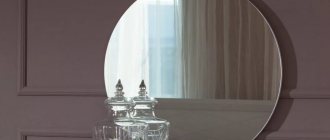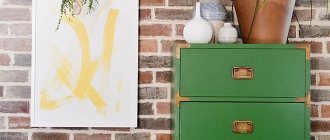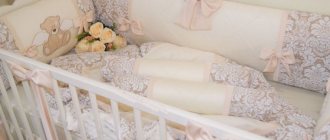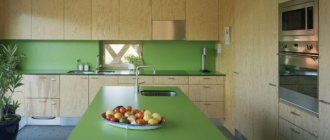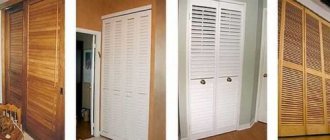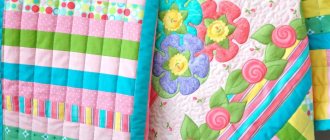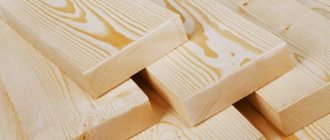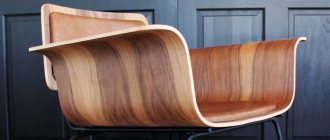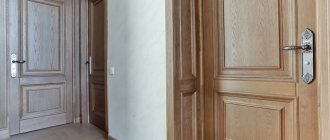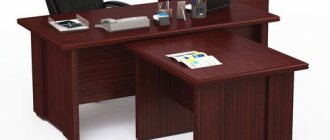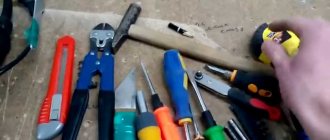Polishing painted MDF facades and panels
Schemes for surface preparation and polishing of MDF with paint coating.
Today, MDF is the most popular material for the manufacture of furniture, especially kitchen facades. MDF can be milled, veneered, or covered with film. We are interested in the processing option when the MDF facade is painted and then polished.
MDF (MDF - Medium Density Fiberboard) is a fibreboard made from small sawdust by hot pressing. It is distinguished from the previous technology - fiberboard - by higher density, ease of processing and environmental friendliness (the absence of phenol in the binder).
There is no universal technology for polishing painted MDF facades. There are a number of general recommendations, but each enterprise selects its own technology experimentally. From this point of view, enterprises can be divided into 2 categories - those that are focused on quick processing and do not pay much attention to the quality of the final product, and those that try to more thoroughly process the surface, using many gradations of abrasive materials and several stages of polishing pastes.
Of course, for high-quality painting it is advisable to use a special dust-proof spray booth or a painting stand with a water curtain.
Polyurethane or polyester materials are used for painting:
- Polyurethane is used more often, consists of spirit components, polymerizes in 24 hours, and ultimately produces a low dry residue. It is quite difficult to process such a surface: it heats up easily, and there is a risk of sanding the enamel; in addition, polyurethane primer “sags” over time, which leads to the appearance of shagreen (orange peel);
- Polyester materials are 3-component, give better results, polymerize in 48 hours; Due to the high dry residue, the likelihood of sanding is much less.
Common defects in MDF painting in average production conditions: shagreen, debris, craters. The larger the debris, the coarser the grain you should start treating the surface with. Ideally, the grain gradation when processing a painted surface starts from P1200, however, in cases of severe defects, it is recommended to use the grain sequence P800 - P1200 - P1500.
The most popular material for preparing varnished MDF for polishing is paper-based Velcro circles with holes. An orbital sander with a dust extraction is used as a drive .
As a rule, in coarser grains, Velcro grinding wheels come with aluminum oxide grain, and finer ones, starting from P400, with silicon carbide grain.
When treating the surface of painted MDF, it is strongly recommended to use microfiber cloths to remove dust before each stage of treatment. Otherwise, dust and particles of material remaining after the previous stage of processing will damage the surface when working with finer grains, and work will have to start again from the previous stage.
Surface grinding process (if defects are detected):
Velcro grinding wheels with holes - P800, P1000, P1200, P1500. We begin to grind the surface from left to right (while trying to ensure that the zones overlap), then in the direction away from us and towards ourselves.
To remove dust inclusions and shagreen, you can also use other grinding materials:
- circles made of abrasive mesh with Velcro P1000 (can leave characteristic “lambs” on the surface);
- Velcro circles on a foam base with P1000 grain.
After the surface is sanded in both directions, the surface is treated with circular movements with an amplitude of 20-25 cm clockwise (in the direction of rotation of the sole, to avoid the formation of “wings”).
If scratches remain after leveling the surface, they can be removed using a Velcro sanding mesh with P2000 grit.
After preparing the surface, the polishing process takes place using polishing pastes. Below are two-step polishing options using Menzerna polishing pastes. At the first stage, a coarser wool polishing wheel with polishing paste is used, at the second, the same or finer polishing paste and a softer foam polishing wheel are used:
PO S100 + fur polishing pad (sheepskin) PO S91L + hard foam polishing pad
PO S 34 + Twisted wool polishing pad PO91L + hard foam polishing pad
PO S34 + felt or fur polishing pad PO 91L + hard foam pad
T10 + fur polishing pad T10 + medium hard foam polishing pad
A12 + fur polishing pad A12 + soft foam polishing pad
In order to avoid “subsidence” of the soil and getting the “shagreen” defect, you can use an insulating primer directly on MDF, for example, polyurethane filler for MDF SIGMAR FPP 0331. It forms an elastic film on the surface that prevents the pile from rising and subsequent subsidence of the paint and varnish layer. This way you can save soil and also simplify further finishing of the surface.
When preparing a piece for polishing, we strongly do not recommend skipping sanding steps. Even if visually the surface of the product seems very smooth and clean, during the polishing stage “under the paste” scratches may appear that remain from the preparation stages, and in this case the whole work will have to start all over again.
Author: Valeria Rumyantseva
We hope that the information presented in the article was useful to you, however, to accurately select tools for your tasks, depending on the materials and series of products, we recommend that you seek advice from our technologists. When using the site materials reference to the source is required.
8 (free in Russia)
WhatsApp, Telegram, Viber +7 999 0258672 /we answer only during business hours/
Mon-Thu 8:30-17:00 , Fri 8:30-15:00
Painting stages
Preparatory stage
At the preparatory stage, you need to pay great attention to the processing of the slab. To treat the surface to a glossy finish, you need to avoid raising the pile and eliminating embossing that occurred during the production process.
The MDF facade should be milled at maximum speed, which will avoid raising the pile. Since the paint layer here is very thin, it is advisable not to leave sharp corners that can be easily knocked off. For cutting corners, it is best to use an edge cutter with a radius of about 3 mm.
To properly sand the MDF facade, it is necessary to remove the surface protective wax layer from the entire surface. An eccentric type grinder is best suited for this work. To process complex curves, it is advisable to use sandpaper. If you plan to paint MDF wall surfaces that include several component elements, then it is better to properly fill the joint gaps with a primer to fill the pores.
Surface priming
At the first stage, the most problematic relief areas are primed. After this, the edges of the panel are primed. At the final stage, the entire facade is treated with soil. Using a primer gun, apply the solution first longitudinally and then transversely. In this case, each subsequent layer is overlapped with the previous one by 50%. This is how not only the primer is carried out, but also the painting itself.
The most effective primer application technology involves two stages. The first step is to use a spray gun to apply a layer of insulating primer. It should prevent the pile from rising and absorbing subsequent layers of paint. After this, you need to let the primer dry and sand the surface with P320-400 sandpaper.
The second step of priming is to apply polyurethane primer and let it dry for at least 10 hours. Next, the surface is ground, and Scotch-brite abrasive is used in places where milling bends are made.
For sanding after applying primer, it is recommended to use sandpaper number p320
Painting stage
To paint an MDF facade with high quality, you need to use a spray gun with paint consumption parameters of 60-200 g/sq. m. All other parameters of the device are set depending on the type of paint coating used. In this regard, before you paint the facade glossy, you need to thoroughly understand the instructions for using the paint.
Wet painting technology
After the priming stage, drying is carried out at a temperature not exceeding 35 degrees. The drying period is on average five hours. The wet painting method is carried out by applying a mixture with a thickness of 120 to 140 microns. It is advisable to use polyurethane paints and varnishes.
The paint is applied using a spray gun with a certain pressure. Application in two layers is also possible, but the surface should be sanded before applying the second layer. At the same time, the thickness of each layer should not be more than 120 microns. At the next stage, several layers of polyester or polyurethane primer are applied to the MDF board, simultaneously with intermediate sanding. The final layer of glossy enamel must be polished.
Question about wood processing after the machine
- Send topic by email
- print version
Question about wood processing after the machine
Post by Razor » Mar 14, 2016 12:35 pm
Re: Question about wood processing after the machine
Posted by AndyBig » Mar 14, 2016 1:01 pm
Re: Question about wood processing after the machine
Post by torvn77 » Mar 14, 2016 1:26 pm
Re: Question about wood processing after the machine
Post by Predator » Mar 14, 2016 4:57 pm
Re: Question about wood processing after the machine
Posted by AndyBig » Mar 14, 2016 5:08 pm
Re: Question about wood processing after the machine
Post by Razor » Mar 16, 2016 1:53 pm
Re: Question about wood processing after the machine
Post by aftaev » Mar 16, 2016, 01:56 pm
Re: Question about wood processing after the machine
Posted by at90 » Mar 16, 2016 2:31 pm
Re: Question about wood processing after the machine
Posted by AndyBig » Mar 16, 2016 3:01 pm
Re: Question about wood processing after the machine
Posted by Patriot » Mar 16, 2016 3:13 pm
Re: Question about wood processing after the machine
Posted by at90 » Mar 16, 2016, 6:07 pm
Re: Question about wood processing after the machine
Post by Razor » Mar 17, 2016 12:02 pm
Re: Question about wood processing after the machine
Posted by AndyBig » Mar 17, 2016 5:25 pm
Re: Question about wood processing after the machine
Post by Razor » Mar 29, 2016 1:03 pm
Re: Question about wood processing after the machine
Post by CactusMan » Mar 29, 2016, 7:00 pm
Re: Question about wood processing after the machine
Post by Razor » Mar 31, 2016 09:52
Re: Question about wood processing after the machine
Post by Kopyloff » Mar 31, 2016 10:58 am
Re: Question about wood processing after the machine
Post by Razor » Mar 31, 2016 12:12 pm
Re: Question about wood processing after the machine
Post by Razor » 01 Apr 2016, 12:17
Re: Question about wood processing after the machine
Post by Razor » 05 Apr 2016, 09:20
- Send topic by email
- print version
- Wiki
- ↳ Wiki of our club: cnc-club.ru/wiki
- Machine tools
- ↳ Milling machines for metals
- ↳ Milling machines for wood and plastics, engraving machines, routers
- ↳ Lathes
- ↳ Laser, plasma and other cutting machines
- ↳ 3D printers
- ↳Robots
- ↳ Other machines
- ↳ Products
- ↳ General questions
- ↳ Machines
- Offers for purchase/sale/services
- ↳ Buy
- ↳ Selling
- ↳ Services
- ↳ Sold
- ↳ Quarantine
- CNC systems
- ↳LinuxCNC
- ↳MESA
- ↳Windows/Mach
- ↳ KFlop
- ↳ Industrial racks
- Software
- ↳ News and announcements
- ↳ CAD packages
- ↳SolidWorks
- ↳ Compass
- ↳ CAM packages
- ↳ Artcam
- ↳ Other Linux issues
- ↳ Other Windows issues
- Machine parts
- ↳ Mechanics
- ↳ Electronics
- ↳ Motors and spindles
- Treatment
- ↳ Materials
- ↳ Tool
- ↳ Video
- Events
- ↳ Events
- Friends' platforms cnc-club.ru
- ↳Chipmaker.ru
- Network resources
- ↳ Internet sites
- ↳ Organizations
- Website
- ↳ Site discussion
- ↳ Offtopic
- Women's section
- ↳ Women's section
- English forum
- Archive
- ↳ Archive
- List of forums
- Time zone: UTC+03:00
- Delete cookies
- Contact the administration
What we didn't know about MDF
What we didn't know about MDF
Post by demonlibra » Dec 15, 2010 5:56 pm
WHAT WE DIDN'T KNOW ABOUT MDF FINISHING Herman FERSMAN MDF (in English - medium density fiberboard, that is, medium density fiberboard) or medium density fiberboard of the dry production method is made by pressing the resulting carpet from wood, ground to the state of fibers, using a binder .
Along with MDF, whose density ranges from 600 to 800 kg/m3, there are different boards whose English abbreviations are written as LDF and HDF, which respectively means low- and high-density fiberboard - from 200 to 600 kg /m3 and over 800 kg/m3.
Not every board is MDF
Fiberboards are more homogeneous than particle boards, making them more suitable for use in furniture products. And they would have completely replaced chipboard long ago if they had the same cost as it.
However, the use of MDF in furniture is constantly increasing. Thus, some of our enterprises have long been producing furniture for living rooms from MDF, lined with films based on polyvinyl chloride. And taking into account the fact that Europe has already adopted a declaration on the gradual abandonment of the use of formaldehyde, which is recognized as a carcinogen, but is still one of the indispensable components of the binder in particle boards, we can expect that MDF may soon become the main material in furniture products.
But the price of MDF directly depends on the density, and our furniture maker, who uses it in his products, tries to purchase a cheaper one, which, of course, turns out to be lighter. After all, there is practically no clear boundary between MDF, LDF and HDF, and no one here checks the actual density of the boards: they are content simply with the name MDF itself.
But only its outer layers, approximately 1 mm thick, have high hardness, almost the same regardless of the declared density of the slab. Deeper it immediately drops sharply to almost half. Milling a slab along the surface reveals the internal volume of the material, where the fibers are bonded together the weaker, the lower its density. With a sufficiently large depth of processing of MDF boards, which are close in their characteristics to LDF, peeling of many loosely interconnected fibers and their bundles is observed, which is why not only the finishing, but also their cladding is subsequently accompanied by the appearance of unevenness on the finished surface. This requires careful additional processing of the milled areas by heat rolling or grinding, which requires significant additional costs - of course, if you try to achieve a high quality finish.
Therefore, in general, it often turns out to be more profitable to purchase a more expensive MDF board, the density of which is on the border with HDF, than a cheaper one, approaching LDF.
Unfaced fiberboards supplied to the consumer have a smooth surface and do not require additional sanding before finishing. Only in case of particularly high demands on the quality of the subsequent varnishing, for example for a high-gloss finish, can the surface of the boards be sanded with sandpapers between 180 and 400 grit (DIN). In any case, complete removal or excessive thinning of the upper smooth surface of MDF, which has the greatest density and hardness, is undesirable.
When finishing, this can lead to the appearance of unnecessary lint or excessive absorption of paints and varnishes into the substrate.
When finishing the surface of parts and products from MDF, the painting operation (similar to finishing substrates made of solid wood or veneer) is completely eliminated. Transparent finishing is used only in the case of preliminary application of texture using imitation or thermal printing methods, as well as to achieve special effects - when using slabs colored in the mass during their manufacture (for example, black, yellow or brick-red).
Therefore, MDF parts are most often subjected to opaque finishing with enamels.
In any case, when choosing a system of paints and varnishes, you should definitely carry out a finishing experiment, since the adhesion to MDF of some compositions supplied by individual manufacturers may be unsatisfactory.
You should also be very careful with finishing materials that are water-based or contain large amounts of solvents, thinners and other liquid components. Their absorption into the slab through the edges and surfaces of the volumes of the internal zone of the slab exposed after milling the reliefs can lead to noticeable swelling, distortion of shape and warping of parts.
Moreover, it is most effective to finish the flat surfaces of the slab using roller machines, but it is impossible to apply paint and varnish materials to MDF workpieces with an in-depth or convex relief milled on their surface using rollers or pouring. Only spraying remains available. In this case, after applying the first primer coating on milled surfaces, pile necessarily rises - that is, fibers or bundles of fibers remaining attached to the surface of the material, rising perpendicular to it due to the action of surface tension forces and remaining in this position after curing of the applied coating.
Their removal in the future can only be done by light sanding by hand or using elastic sanding drums.
The most commonly used are combined sanding belts and brushes based on circles of petals, or brushes consisting of abrasive-filled synthetic fiber.
High gloss coating
The high gloss of the finished coating on the surface of MDF is achieved only with the use of appropriate finishing materials and with strict adherence to pre-tested technology specified by the manufacturer of the paint and varnish material. But, in any case, the application and curing modes that have already been tested will only be applicable to a slab of the same quality, from the same manufacturer and with the same characteristics as the one on which they were tested.
Other important factors determining the high gloss of the coating are the quality of the initial and intermediate sanding, as well as the complete absence of dust in the finishing room. Cleaning the rooms where primers and varnishes are applied from dust is achieved by constantly cleaning them, including not only floors and equipment surfaces, but also building structures.
These areas should be completely separate from other areas where grinding is carried out. Dust leakage from them through leaks in building structures and doors must be prevented by correct calculation of the volume of air flow provided by supply and exhaust ventilation.
In recent years, the use of so-called “clean rooms” has become quite popular - structures inside the workshop, equipped with their own supply and exhaust ventilation system, in which coatings are applied and dried (or cured).
Their huge disadvantage, which is almost always forgotten, is the need to preheat the supply air during the cold season, which requires huge amounts of energy, the price of which is constantly increasing. In the warm season, this air must be cooled, which requires air conditioning systems, which is often simply not discussed.
For some reason, only a few people know that lining the relief surfaces obtained on the surface of MDF by milling with thermoplastic films with a printed wood grain pattern can in some cases be successfully replaced by transferring the same pattern onto their faces and edges from a special film using thermal printing.
For this, the same membrane-vacuum presses are used as for lining with thermoplastic films, and the wood texture pattern obtained on the slab or any fancy decor is quite durable and in many cases does not require subsequent finishing with varnishes at all. MDF typically has a yellowish-brown color, which is an excellent background for simulating the grain of many types of wood, and pre-painting the surface before thermal printing is not required. Moreover, the design can be composed of thermally printed films of various textures and colors, up to the production of decors on the substrate that imitate mosaic, intarsia or marquetry.
MDF milling
MDF milling is currently one of the most popular types of orders for CNC equipment. Previously, you could spend a lot of time doing manual processing because... the material is not very simple and behaves quite unstable when processed.
One of the first problems that arises is the hairiness of the material after processing. From our experience, we can recommend a couple of simple techniques to obtain a product of proper quality.
1. Selecting the material itself for milling MDF. The practice of CNC processing of MDF has shown that with a thickness of up to 16 mm, it is better to buy MDF from a Russian manufacturer, it is denser and the hairiness is very low. When purchasing material from 16 mm, it is better to pay attention to foreign manufacturers, for example Germany, it is better than domestic in terms of the above indicators.
2. MDF storage location. If you buy material that has been lying on the street, there is a 100% chance that it will be raw, i.e. absorbed moisture, and MDF absorbs it very well. Accordingly, the hairiness will be very high, and you will spend a lot of time refining the surface of the final product.
3. How to properly process MDF after CNC milling. There are two good methods for dealing with post-process lint, but they all involve working with sandpaper by hand. First, the MDF needs to be varnished; the varnish needs to be penetrating; the so-called ship varnish is often used. With it you definitely need to withstand the technology; the task that faces you is to create a dense crust on the outer surface of the product. The product is coated with varnish three times, each time it is necessary to knock down the pile after drying so that the varnish does not build up on it. Second, you can use a quick-drying primer; at the moment there is a large selection of such primers, but, just like with varnish, you need to knock off the pile after drying. Working with primer is much more pleasant and safer, especially if you choose the right color, you will be able to see all the defects on the product that can be removed; this is more difficult to do with varnish.
4. Gluing. If you need to glue several layers, it is very important to know that when sanding, the adhesive seam is much denser than the material itself, so you can create a large number of unnecessary holes in the material.
5. Tool. To process MDF, you can use single-tooth or two-tooth cutters, but you should not use worn cutters for processing, they also raise the pile! 6. Gluing. Ideally, you can glue MDF only under pressure, then the seam between the sheets will be very thin and barely noticeable. Unfortunately, a press is not so easy to find, so you can take a simpler route and glue the MDF together by tightening it with self-tapping screws, which will naturally leave holes that will have to be puttied. VERY IMPORTANT: keep in mind that the glue is absorbed into the material and forms a denser structure near the seam. In other words, when you start sanding in the seam area, if you sand too hard, you will create holes because... material without impregnation is softer.
Using these tips, you can easily make high-quality products, such as: models for foundries, models for automobile molds, MDF products for painting. Well, if you don’t have the equipment or you can’t make a quality product, you can always contact us at the Qmill Company and we will help you make your order. You can view products obtained by CNC milling on this page of our website or by sending a request by email
Qmill has been working in the woodworking industry for many years. Woodworking for us is, first of all, high-quality work by hand and competent CNC work. Experience with CNC equipment allows us to solve many issues and problems in the shortest possible time and save on the manufacture of certain products while maintaining stable, good quality of manufactured products. Our production has about 6 CNC machines, which solve both single and serial problems.
We mainly work with contractors on the interiors of bars, hotels, and restaurants, but we also take on turnkey projects. Our equipment can produce both three-dimensional and flat interior elements with the possibility of artistic painting of the final products. We produce threaded posts of various diameters and perform artistic cutting of materials such as MDF and PVC.
Along with general woodworking tasks, we often encounter orders for the production of molds from model plastic and prototypes of products for industrial design and prototyping; using 3D equipment we can produce quite complex shapes and surfaces of any size.
CONSULT ABOUT YOUR ORDER OR LEAVE A REQUEST FOR FREE
Order a free estimate of your project
Leave your contact details and our specialist will contact you within 20 minutes
Advantages of processing MDF on new generation machines
To carry out work, CNC milling machines are most often used, having processing zones of 3000x2000x300 mm or 2050x1300x250 mm. The use of such equipment expands the range of milling parts, ensuring high processing accuracy, labor productivity and achieving the highest quality standards.
To perform different operations, various cutters are selected. Moreover, from various manufacturers in Russia and abroad. The cutter is intended for:
- processing of MDF edges, facades - soldered with carbide plates;
- making side edges and grooves, removing edge overhangs;
- making table edges (one or a whole set);
- single-sided profiling or double-sided edge processing;
- radius and angled edge processing;
- milling of reliefs and gratings;
- processing the side edge of the platband.
The 3-axis CNC machine, used for 2D and 3D processing of parts, has two work tables - classic and removable, so it is used for all kinds of work. And software control guarantees the highest accuracy of order fulfillment. Work on a machine with numerical control - according to a precisely specified template, which eliminates errors and defects.
How to paint MDF yourself
The abbreviation MDF stands for finely dispersed fraction. This material, invented in 1966 in the USA, is a slab of medium-density wood fibers pressed under high pressure.
Today MDF has gained universal recognition, for example, among furniture manufacturers. And if you have pieces of MDF furniture at home, they can easily be repainted - this is an inexpensive and effective way to change the situation. In addition, painting can additionally protect MDF surfaces from negative environmental factors.
Modern technologies and materials make it possible to paint kitchen facades or other pieces of MDF furniture at home quite efficiently.
- Paints that can be used
- Types of varnishes
- Sanding and sanding the surface
- Primer coating
- Applying paint
- Varnishing
- Expert advice
Why varnish
Coating MDF panels with varnish is required quite often. Why? There are several reasons.
- The varnished surface easily copes with increased ambient temperatures. For example, you can place hot dishes on a varnished table made of MDF.
- Using varnish you can create various decorative effects. It can be glossy, matte-silky surface, mother-of-pearl, etc. It is noteworthy that similar effects are used for both interior and exterior decoration.
- High-quality varnishes will not make MDF panels less environmentally friendly.
- The coating significantly increases the service life of the product.
There is one drawback. Varnished or painted structures/slabs are more expensive than regular ones.
Paints that can be used
To paint MDF boards yourself, it is best to take enamels, since they form a durable opaque film and come in glossy and matte finishes. The following materials can be used:
- alkyd, alkyd-urethane or oil-based enamels;
- based on polyurethane resins;
- acrylic enamels;
- nitro paints of the NTs series;
- professional two-component polyurethane enamels;
- specialized enamels for MDF;
- automotive enamels.
Each of these materials has its own characteristics. But perhaps the last two items on the list have the best properties.
It is especially worth noting that in industrial conditions today powder coating of MDF facades is often used. This method is extremely economical and makes it possible to achieve high mechanical and chemical costs. The method is based on the ability of unlike charges to attract each other. It was originally used for ceramics, metals and other materials that can withstand high temperatures.
Types of varnishes
Instead of painting, you can choose varnish. To reliably varnish MDF, you need to apply several layers and wait until it dries completely each time. The process will take a long time and require effort.
If you still decide to choose a varnish, then pay attention not only to its cost and composition, but also to wear resistance, resistance to humidity, and high temperature. To coat MDF boards at home, you can use several different types of varnishes.
The cheapest compositions in this segment are alcohol-based and have a short drying time (up to half an hour), that is, they are quick-drying. Traditional inexpensive varnishes include oil-based varnishes, which not only give a beautiful appearance to surfaces, but also effectively protect them from moisture.
Note! For coating MDF countertops, an excellent choice would be two-component epoxy varnishes, which are characterized by increased resistance to impact.
Acrylic varnishes are good because they are odorless, do not emit toxic substances, and are not washed off or diluted with water. Another popular option is polyurethane varnish. It is characterized by enviable wear resistance and good adhesion to wood-based materials.
As for those cases where further polishing of MDF products is expected, nitrocellulose varnishes are the best option.
If you want antique
If there is a desire to give the surface a more expressive look, to age it a little, then they resort to patination. It is advisable to do this when there are drawings and patterns.
Patina is applied in this way:
- walk over the selected area with a sponge soaked in the mixture;
- leave until completely dry;
- the painted area is sanded;
- proceed to the final stage.
You can create the effect of artificial aging yourself by resorting to patination of the surface
Sanding and sanding the surface
In paint and varnish work, home or industrial, proper surface preparation is important. In order for the paint to adhere well to the MDF board in the future (for example, on facades or wall panels), it is necessary to first sand them.
Certain tools are required for grinding:
- sandpaper;
- soft abrasive of fine grain;
- sanding machines for primer.
If the product to be painted is small in size, then use sandpaper on foam rubber in a grade from P220 to P280. To clean large flat surfaces, fine-grained sanding mats of the 700 series are used. The same materials can be used to remove excess soil in the future.
MDF facades are sanded over the entire plane, removing the top layer of varnish. Complex curves in the milling of MDF facades, edges, edges and ends are best cleaned with the same sandpaper.
When sanding, you must follow the technology for removing old varnish, you must not allow the surface to overheat (if you are using a power tool), and you must not allow so-called marks (scratches) to appear on the lamination. The wood-fiber surface, as a rule, is located under a decorative laminated film, so when sanding, you cannot wipe the top layer to holes. The chips are separately cleaned of dirt and the edges are sanded.
After sanding, the surface will become matte and rough. Then the dust is swept away (sucked in with a vacuum cleaner), and the surface of the slab is washed with a solvent. It will remove possible fat deposits, excess moisture, and dirt.
RETAIL PRICES WITH VAT FOR PAINTING
Matte varnish - 2,400 ₽/m²
Glossy varnish – from RUB 3,900/m²
Matte enamel — 2,990 RUR/m²
Glossy enamel — 4,400 RUR/m²
PRICE LIST FOR PAINTING
The price includes certified paints and varnishes:
SAYERLACK, RENNER, Votteler, VeroMetal, MOBIHEL, SPIES HECKER
The choice of color is carried out according to catalogs: RAL, NCS, PANTONE, WCP.
We can tint the paint to match your sample if there is no suitable color in the palettes.
Primer coating
Before painting, it is highly advisable to treat MDF with a primer. This processing is carried out in two passes. At the first stage, the insulating soil is sprayed using a spray gun at the rate of 90-100 grams per square meter.
Note! If you intend to paint laminated MDF board (LMDF), then you can do without priming and immediately move on to the next step.
The primer should prevent new paint or varnish from being absorbed into the MDF board. The soil gets into all loose areas of the MDF, which means that the paint will not sag in the future. After the primer has dried, the surface is carefully sanded with sandpaper or sandpaper.
To form the second layer, it is best to use white polyurethane primer. Here the consumption should be 150 grams per square meter. And this layer of soil must be given a certain time to dry - up to 24 hours.
If we talk about general recommendations for priming MDF, it is carried out with a spray gun. If you don’t have a spray gun, then you can use a brush. First, the most complex elements of the cutters are processed, then the edge and the rest of the surface. For the first time, the part is coated lengthwise, and the second layer is made across the direction of the strokes of the first.
Dyeing technology
MDF panels are painted with a thin layer of paint two or three times. Before applying paintwork materials, the surface must be degreased (wipe with acetone or solvent), primed and sanded. After painting, the furniture façade can be varnished. However, varnishing of MDF boards should be carried out no earlier than 30 days after painting.
The paint dries quickly, but its polymerization process occurs more slowly. Typically, the paint layer hardens within a month.
Main stages of painting MDF panels:
- cleaning from dust and dirt;
- degreasing, removing oil stains with acetone or solvent;
- sanding with fine-grained sandpaper;
- primer treatment for finely porous bases;
- drying the surface for 24 hours;
- final polishing;
- coloring;
- application after 30 days of varnish.
See also
Table for mixing colors of acrylic paints and a color palette for work
Padding
Before painting, MDF panels must be primed with a special primer for finely porous surfaces. It is recommended to sand the slabs first. After applying the primer by spraying, a day later it is advisable to lightly sand the MDF again. It is important to remember that the final result of painting depends on the correct primer. If the slabs are not primed, the paint will simply drain from them.
Coloring
Painting of MDF panels is carried out using a short-haired (foam) roller or sprayer. A more even and uniform coating is achieved by using a spray gun. The slabs should be painted in a horizontal position, in straight, wide stripes (along their length). Painting is carried out in 2 or 3 layers. It is forbidden to fill the panels with paint. The paint layer must be very thin. During the painting process, adhere to the interlayer interval to dry the paint.
Finish and varnish
At the final stage (a month after painting), the MDF surface can be varnished. It is recommended to use a type of varnish that is compatible with the paint. You can not paint MDF, but immediately varnish it. The surface will first have to be sanded and primed. Polishing the panels will help create the roughness necessary for adhesion of any paintwork material.
Expert opinion
Zakharova Irina Yurievna
Cleaning professional with 15 years of experience. Our best expert.
Ask a Question
The following varnishes are used for varnishing MDF: acrylic, two-component polyurethane, alkyd, nitrocellulose. Any of these compositions will give the facade a gloss after drying.
It is advisable not to use oil-based varnishes. They take longer to dry and are used only on natural wood. Varnishes are applied to the surface using flat brushes, velor rollers or a spray gun.
Applying paint
After priming, it’s time to directly apply paint. Here, in principle, there is nothing complicated. First, prepare the dye according to the manufacturer's instructions. Then take the spray gun and adjust it so that its coverage area is small. This allows you to use material economically and paint as thoroughly as possible.
Painting MDF facades or other products made from this material begins with the most problematic (for example, covered with cracks and scratches) areas. And only after that the rest of the area is painted over. To achieve the best result, it is worth applying several layers. Moreover, after each layer it is necessary to take a break from twenty minutes to several hours to dry.
If you have no experience working with a spray gun, then you should first conduct training on some unnecessary piece of wood. Of course, you can use a roller or brush, but in this case there is a risk that the surface will not be perfectly smooth and even.
Solving common problems
Possible problems and methods for solving them:
- if the surface “blows away” after painting, it means that the paint was applied to a damp base (the MDF board must be thoroughly dried before painting);
- if the paint layer lays down unevenly, it means that the panels have not been cleaned of oil stains (the base must first be degreased with acetone);
- if the paint does not adhere to the surface, it means that the MDF was not sanded or primed (the boards must be sanded and primed before painting).
Varnishing
After painting, in most cases it is also necessary to varnish the product. The first layer of varnish, prepared for use, is applied at the same rate as primer (150 g per 1 sq. m).
The second layer is applied after the first layer has completely dried. Then, when this paint dries, you need to sand the MDF panel again. First, coarse-grain sandpaper is passed over its surface, and then fine-grained sandpaper is used. To prevent lumps from rolling off, the treated area is periodically moistened with water.
Another week after this, the MDF must be additionally polished with a sander and abrasive paste. This is the most correct technology, although at home, when working with your own hands, it is sometimes not followed, limiting yourself to ordinary varnishing.
Expert advice
Experts recommend using a sprayer for painting, because after using a paint brush or roller, traces of lint will remain. Often painted furniture is placed in a place where the sun's rays fall on it from different angles. And in this case, all the shortcomings of the face coverings will be very clearly visible.
Note! The least traces are left when using a roller with a fine pile - if you don’t have a spray gun, then it’s better to choose this particular tool.
It happens that you need to paint not only the outer side, but also the back side of the MDF board yourself. In this case, you should take a break between these two operations and wait until it dries. The time it takes for a particular paint to dry is usually indicated on the packaging, but you need to take into account the microclimate in the room and make appropriate adjustments.
When painting MDF with your own hands, many are tempted to use an aerosol can. However, experts advise refraining from this impulse. Aerosols are really easy to work with, but the quality of the coating ultimately leaves much to be desired - professionals have many complaints about it.
Paint that dries for a long time hides defects better. Quick-drying materials clearly lose out here - some cracks and irregularities remain noticeable.
It happens that mistakes in painting or too deep damage become noticeable after the work is completed. In this case, they can be masked with self-adhesive film. You just need to choose the desired pattern in the store and carefully glue the film onto the facade of the furniture.
The pile on MDF boards does not rise, like that of natural wood materials, and this must be taken into account when purchasing paints, primers, and varnishes. The fact is that the price of a non-lint coating is higher than usual, so you shouldn’t overpay for unnecessary benefits.
Subtleties of the technological process
Today, the use of milling machines has become ubiquitous. And the advantage of the CNC system is that the milling tools are automatically set in motion, obeying the software setting. Since milling equipment is used to perform curved cutting of MDF, milling of reliefs, three-dimensional figures and images at high processing speed, the preparation for these processes becomes more complicated.
Special requirements apply to electronic drawings in ArtCAM, AutoCAD, Solidworks and Corel Draw (versions 8 to 14), with corresponding extensions.
For curvilinear cutting of MDF and milling of volumetric patterns for facades, a 3D layout is developed, and the files are provided in STL format. For 2D milling, DWG and DXF files are acceptable. This also applies to the option when milled facades are made from MDF for the subsequent assembly of cabinet furniture.
